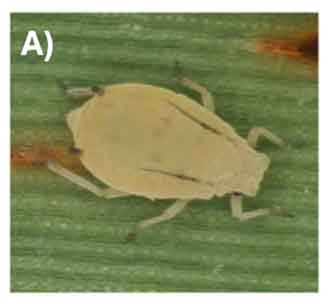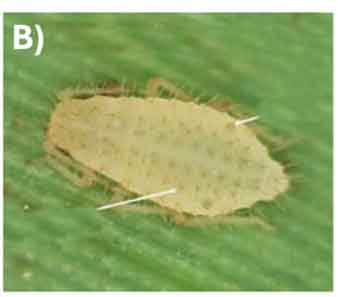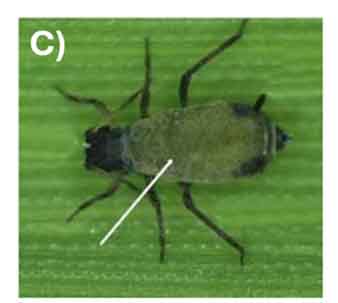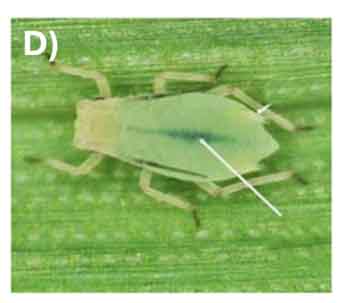Start Scouting for Sorghum Aphids – August 21, 2024
Treatable numbers of sorghum aphids (Melanaphis sacchari) have been spotted in sorghum fields located in parts of north-central Oklahoma and the Oklahoma panhandle (Figure 1). For now, these large numbers of sorghum aphids have been found primarily at the edges of fields where pigweed and Johnson grass are found. With populations building in some locations they could spread within fields. These populations may or may not continue to rise over the next month. While this pest is nothing new to Oklahoma, we felt some reminders of how to scout, when to treat, and management options would be useful.
Figure 1. Sorghum leaf with high population of sorghum aphids (Melanaphis sacchari). Photo courtesy: J. Lofton, Oklahoma State University.
What are you looking for?
The sorghum aphid, formerly known as the sugarcane aphid, is a small light tan to yellow insect that has black feet, black antennae, and black cornicles (aka tailpipes: two projections off the back of the aphid’s abdomen) (Figure 2A). Below are photos of some common aphids that we encounter in Oklahoma to help give a comparison of the sorghum aphid to others you may find in your fields (Figure 2). For more information on these other aphids check out the OSU Extension Fact Sheet EPP-7099. Look closely as aphids will often reside on the underside of the leaves away from the sun and can nestle against the rib of the leaf. Pay attention to lady beetles, their larva and other natural enemies when in your fields, they may help clue you in to where these aphids might be.
| Image | Caption |
|---|---|
 |
A) Sorghum aphid (formerly known as the sugarcane aphid or “SCA”). |
 |
B) Yellow sugarcane aphid. |
 |
C) Corn leaf aphid |
 |
D) Greenbug. Photographs courtesy: OSU IPM. |
Figure 2. Aphids common in Oklahoma cropping systems.
How do you scout for the sorghum aphid?
Growers should scout their fields once a week and increase scouting to twice a week once the sorghum aphid is detected. There are two options for scouting: 1) the SCA Glance-N-Go App that you can download from the Google Play or Apple App store (follow the instructions here to download) where you can enter your control cost ($/acre), price of grain ($/bushel) and track the plants that have 50 or more aphids total between a top and bottom inspected leaf. The app will determine if you should treat or not based on the information you provide (click on the information icon on the App homepage for detailed instructions on how to scout with the app) A YouTube Video on how to use the App can be found here. Or, 2) utilize the information below and take a pen and piece of paper with you into the field.
Walk about 90 feet into the field and inspect the top and bottom leaves of 3 consecutive plants. Estimate the average number of aphids found per plant. Then move over 5 rows and sample 3 more consecutive plants. This is considered one “stop” (6 plants will be inspected per stop). Next, move 30 feet from the first stop into the field using an inverted “U” shaped pattern (Figure 3) in the field and sample 6 more plants for the next stop (top and bottom leaves of 3 consecutive plants, walk 5 rows, then top and bottom leaves of 3 consecutive plats). Collect counts for a total of 9 stops (6 plants X 9 stops = 54 plants inspected) and estimate the percentage of plants that averaged at least 50-125 aphids per plant using the following formula: # plants with 50-125 aphids/54 * 100 = % of infested plants above threshold.
Figure 3. Scouting guidance for the sorghum aphid. Scout in a “U” shaped pattern into the field. Inspect the top and bottom leaves of 6 plants, record the estimated number of aphids, and walk 30 feet to the next stop to repeat the inspection for a total of 9 stops (54 plants total inspected). Image courtesy: T. Royer and J. Lindenmayer, Oklahoma State University.
How do I know if I should treat for the sorghum aphid?
Ultimately it will depend on the growth stage of your sorghum. Sorghum aphids can cause damage any time from seedling emergence through harvest but is more likely to occur from boot to soft dough. Heavy feeding causes early leaf senescence and reduces seed fill. Growers should consider their return on investment to guide whether they treat or not. If you use the SCA Glance-N-Go App, the App will tell you whether to treat while considering the control cost and the price of grain.
If you are using the pen and paper method described above, then the recommendation for control of the sorghum aphid is to treat if 25% of plants are infested with 50-125 aphids per leaf. It is important to not spray until suggested thresholds are reached, but if needed; apply the spray with the highest amount of water carrier as possible (5 or more gallons/acre by air, or 10 or more gallons/acre by ground). Spraying too early and with inadequate coverage may require a second application from sorghum aphid recolonization.
What can I spray for sorghum aphid control?
When selecting an insecticide be aware of the grazing and post-harvest interval (PHI). Suggested insecticides for sorghum aphids include Sefina and Transform WD. Sivanto 200 SL and Dimethoate 4E are also options, however these are broad spectrum insecticides that can reduce beneficial insect populations that may be providing natural control of the sorghum aphid. Per the United Sorghum Checkoff Program, when other insect pests like headworms and midge are present at threshold levels it may be tempting to use an inexpensive pyrethroid to control these pests. The use of pyrethroids in fields where sorghum aphids are present may cause the aphid population to increase due to the reduction in the beneficial insect population. Under these conditions, consider using Prevathon, Blackhawk or other appropriate insecticides that maintain the beneficial insect population (such as lady beetle adults and larvae, hoverfly and lacewing larvae, and parasitic wasps) critical for keeping sorghum aphid numbers in check.


